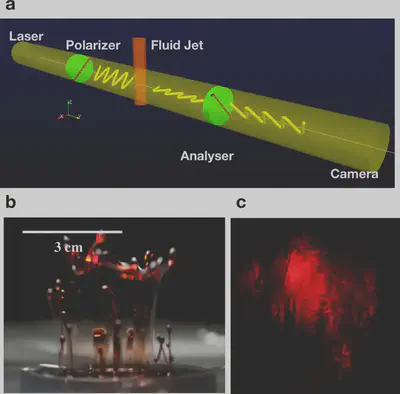Crossed polarizer setup for polymer extension
Evidence of polymer stretching in jets using crossed-polarizer
Scenario: polymer solution jets form on Faraday excitation at larger amplitudes. The jets do not break unlike in Newtonian (non-polymeric) systems such as glycerine solution at the same viscosity. We hypothesize that in such jets the polymer chains extend much like they do in the typical bead-chain formation in jets studied in polymer rheology. And offer evidence of stretching in such Faraday excited jets.
High-speed imaging by itself may not show the evidence sought. On the other hand, a capillary breakup extensional rheometry-like measurement also seems very difficult (if possible) in such a highly dynamic system though very high speed imaging may help. We offer two experimental signatures of extension in such jets in our work.
When polymers are in their rest-state, they are coiled and their properties are expected to be isotropic. Upon extending or stretching, the system becomes anisotropic. A measurement of the anisotropy would then point to an extension of the polymer chains (and subsequently to elastic stresses etc.). One way to observe this for any polymer is to measure the birefringence wherein the refractive index differs depending on the direction and thus leads to the splitting of a light beam. But the orientatinal birefringence may be a measurement in parts per thousand (order 10^{-3} or less) and depends on the amount of stretching. Such a measurement in a dynamic experiment where the jet lifetime may be 100 ms is difficult. So we turn to indirect methods using polarization and tip acceleration. In our experiments, the tip acceleration was observed to be higher during the fall of the jet than the acceleration due to gravity, indicating a pull from below. This indirectly hints at stretching since the elastic stresses may then add up along with gravity to exhibit non-parabolicity during falls (in comparison, observed solar spicule stresses exhibit a spread around local gravity).
To study polarization, it would then be required to inroduce anisotropic absorption. Though birefringence exists in plain polyvinyl alcohol solution jets, we turn to the decades-old technique of iodinating it to observe polarization (in fact, such iodinated-PVA based sheet polarizers were very common until recently). As a backstory, the method described below dawned on me subsequent to a nice discussion with my colleague Rema Krishnaswamy who introduced me to the wonderful world of polymers. Initially I did go on a wild-goose chase involving the highly attractive Cetyltrimethylammonium bromide or worm-like micelle system and thought hard on using birefringence (another colleague Richard Fernandes had worked with polymer birefringence and gave invaluable advice…not to try measuring that with the apparatus I had at hand!). Soon I realized there is an easier way.
Upon doping by I_2/KI, Iodine forms complexes with the polymer chain branches (there exists another interesting configuration!). The valence electrons due to Iodine dopants are free to traverse the length of the extended polymer chain using the absorbed light and hence this is the ‘OFF’ polarization direction. In the transverse direction though, light passes through unhindered and is the ‘ON’ direction.
The polarization setup I used is shown in the schematic below. To begin with, we introduce a polarizer aligned with the laser. A crossed polarizer placed in the path would block light completely. However, a polymer jet introduced in between, that partially polarizes light due to the extension of polymer chains inside, would allow some transmission if placed as shown in the figure at 45-135 degrees.

Control experiments to verify this phenomenon include comparison between 0-90 and 45-135 degrees configurations of the polarizers, using suspended drops of the solution to test isotropic behaviour, and introducing stretched iodinated-PVA dried film for comparison. Although we haven’t performed quantitative measurements, it may be possible to estimate the amount of stretching (that may be useful in extensional stress calculations) using the in-built 10-bit resolution offered by regular DSLRs.